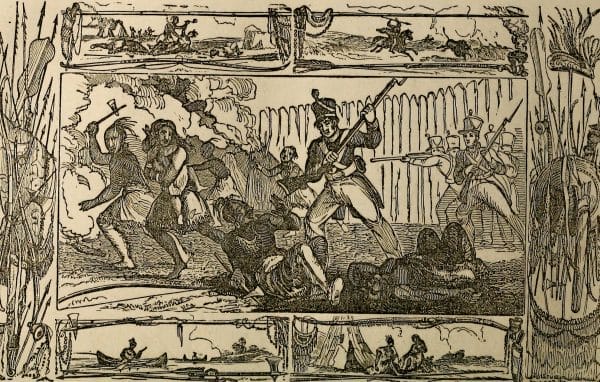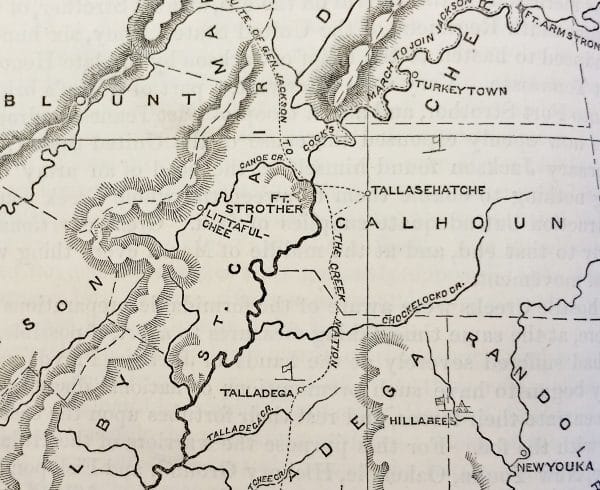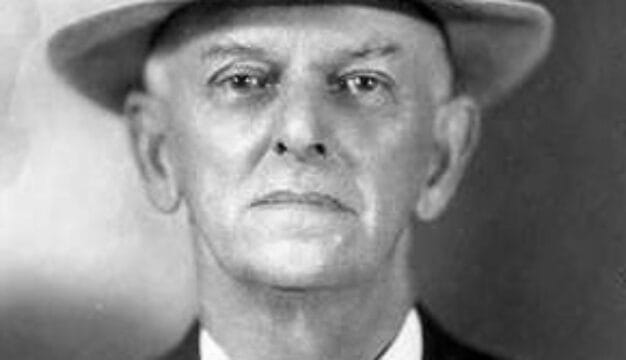Battle of Tallushatchee
The Battle of Tallushatchee, which took place on November 3, 1813, in present-day Calhoun County, was America’s first military victory in the Creek War of 1813-14. The battle was initiated when an overwhelming American force attacked the Creek town of Tallushatchee, resulting in its complete destruction and the death of 186 Creeks, including women and children.
 Battle of Tallushatchee
The Creek War of 1813-14 had begun as a civil war between two principal factions of the Creek nation. The traditionalist faction, known as the Red Sticks, resented what they viewed as the accommodationist actions of the Creek National Council, which favored working with encroaching settlers. This civil war soon expanded into a confrontation with the United States after approximately 700 Red Stick warriors attacked Fort Mims in present-day Baldwin County on August 30, 1813, killing some 250 defenders and civilians, including women and children. This brutal attack resulted in a retaliatory invasion into the Creek Nation by American military forces from Mississippi, Georgia, and Tennessee.
Battle of Tallushatchee
The Creek War of 1813-14 had begun as a civil war between two principal factions of the Creek nation. The traditionalist faction, known as the Red Sticks, resented what they viewed as the accommodationist actions of the Creek National Council, which favored working with encroaching settlers. This civil war soon expanded into a confrontation with the United States after approximately 700 Red Stick warriors attacked Fort Mims in present-day Baldwin County on August 30, 1813, killing some 250 defenders and civilians, including women and children. This brutal attack resulted in a retaliatory invasion into the Creek Nation by American military forces from Mississippi, Georgia, and Tennessee.
In October 1813, Gen. Andrew Jackson led a group of approximately 2,500 Tennessee volunteer infantrymen and joined up with Brig. Gen. John Coffee‘s 1,300 cavalrymen in Huntsville. After leaving forces to establish a supply base near Huntsville, the remainder of the troops crossed Raccoon Mountain and began constructing Fort Strother on the Coosa River at a site known locally as Ten Islands about 30 miles south of present-day Gadsden. Jackson’s plan was to launch strikes from this rendezvous point against the Red Stick towns.
 Creek War Site Map
Upon learning of the presence of a sizeable Red Stick stronghold nearby, Jackson dispatched Coffee and 900 mounted troops to destroy the Creek town of Tallushatchee, 13 miles east of Fort Strother. Early on the morning of November 3, 1813, Coffee’s troops had progressed to within a mile of Tallushatchee, at which point they split and completely surrounded the Red Stick village. Two detachments of scouts were then sent into the heart of the village in an effort to draw the warriors out of their houses. In response, the Red Sticks rushed to the outer perimeter of federal soldiers, where they were driven back by a hail of lethal gunfire. Fighting lasted until the last warrior fell. In all, 186 Red Sticks were killed, including a number of women and children. The remaining women and children were taken prisoner. Coffee’s troops, by contrast, suffered only five killed and 41 wounded.
Creek War Site Map
Upon learning of the presence of a sizeable Red Stick stronghold nearby, Jackson dispatched Coffee and 900 mounted troops to destroy the Creek town of Tallushatchee, 13 miles east of Fort Strother. Early on the morning of November 3, 1813, Coffee’s troops had progressed to within a mile of Tallushatchee, at which point they split and completely surrounded the Red Stick village. Two detachments of scouts were then sent into the heart of the village in an effort to draw the warriors out of their houses. In response, the Red Sticks rushed to the outer perimeter of federal soldiers, where they were driven back by a hail of lethal gunfire. Fighting lasted until the last warrior fell. In all, 186 Red Sticks were killed, including a number of women and children. The remaining women and children were taken prisoner. Coffee’s troops, by contrast, suffered only five killed and 41 wounded.
The lopsided American victory was the result of an overwhelming disparity in the size of the opposing forces, as well as a shortage of gunpowder among the Red Sticks, many of whom were forced to defend themselves with only bows and arrows. Legendary frontiersman Davy Crockett, among the attacking Tennessee volunteers, reported that 46 warriors were shot and the house in which they had sought refuge was set ablaze by Coffee’s troops. Coffee later defended the loss of life among Creek women and children by blaming the warriors for seeking refuge in houses with their families and claimed that the killing of noncombatants was unintentional.
One of the Creek children orphaned by the fighting was taken from the battlefield to Fort Strother, where he caught the eye of General Jackson. The ten-month-old boy, named Lyncoya, was the same age as Jackson’s adopted son, Andrew Jr. When Creek women prisoners refused to care for him, Jackson arranged to have the baby sent to Huntsville and provided financial support for his immediate care. The boy later was adopted into the Jackson family and lived at their home near Nashville, Tennessee.
The outcome at Tallushatchee was significant not only because it was the U.S. military’s first victory of the Creek War but because it helped to sway leaders of many Creek towns to the American side. It also boosted the confidence of the American forces and addressed the clamoring among frontier citizens for revenge after Fort Mims.
Additional Resources
Griffith, Jr., Benjamin W. McIntosh and Weatherford: Creek Indian Leaders. Tuscaloosa: University of Alabama Press, 1988.
Halbert, H. S., and T. H. Ball. The Creek War of 1813 and 1814. 1895. Reprint, Tuscaloosa: University of Alabama Press, 1969.
Waselkov, Gregory A. Conquering Spirit: Fort Mims and the Redstick War of 1813-14. Tuscaloosa: University of Alabama Press, 2006.



